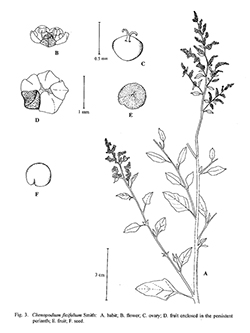e-Flora of Thailand
Volume 7 > Part 2 > Year 2000 > Page 254 > Chenopodiaceae > Chenopodium
2. Chenopodium ficifolium Smithwfo-0000601268
Fl. Br. Ind. 1: 276. 1800; Ohwi, Fl. Japan 415. 1965; K.Larsen, Thai For. Bull. 13: 34. 1980; Fl. C.L.V. 24: 96. 1989; P.H.Hô, Câyco Viêtnam I. 2: 917, fig. 2578. 1991. Fig. 3.
Accepted Name : This is currently accepted.
Synonyms & Citations :
Description : Annual herb up to 1 m. Stems covered by vescicular hairs giving the plant a mealy touch. Leaves rhomboid to lanceolate, with sinuate margin, up to 7 by 4 cm, diminishing in upper parts to 1–2 by 0.7–1.5 cm, attenuate at base, obtuse-mucronate at apex, upper surface green, lower greyish, mealy. Inflorescence richly branched, leafy in lower part. Perianth divided to about the middle; lobes carinate. Stamens 5. Ovary spherical-ovoid. Fruit with perianth pentagonal in outline. Seeds discoid, ca 1 mm diam., black, shining with numerous radial lines.
Thailand : NORTHERN: Chiang Mai, Chiang Rai; NORTH-EASTERN: Loei; EASTERN: Ubon Ratchathani; CENTRAL: Chai Nat.
Distribution : Widely distributed in Europe and Asia (type not designated).
Ecology : Forming large populations on sandy flats along the large rivers. Probably spreading in Northern and Central Thailand during the second half of the century.

